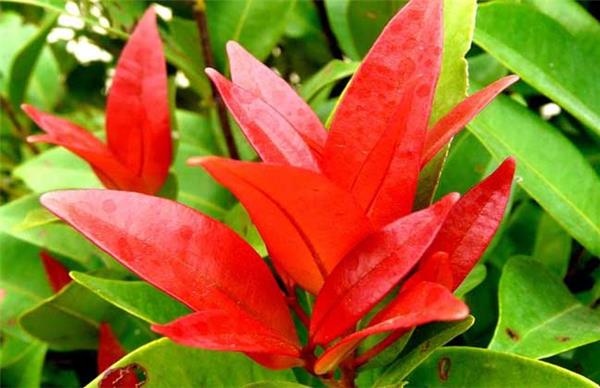Control methods of diseases and insect pests of Photinia rubra
Photinia rugosa is a general term for hybrids of the genus Photinia of Rosaceae. It is named for its bright red shoots and tender leaves. There are many varieties of its cultivation. The common diseases are leaf spot, anthracnose, gray mold, and so on. Common pests are aphids, shell insects, longicorn beetles and so on. Let's take a look at the common pest control techniques of Photinia rubra.

Grey mold disease
[hazard characteristics] Botrytis cinerea is mainly harmful to twigs, young stems, leaves, flowers and fruits of Photinia rubra. At first, the spot is watery, then it expands into a large gray spot and has an irregular wheel, and finally the infected area is covered with gray mold layer until it is necrotic or rotten.
[control methods] at ordinary times, strengthen cultivation management, pay attention to eliminate stagnant water, reduce humidity, and remove diseased and disabled bodies. 50% carbendazim 800-fold spray can be used to prevent the onset of the rainy season, and 50% carbendazim 800-fold spray or methyl topiramate 800-fold spray can be used during the onset of the disease.
Leaf spot disease
[harm characteristics] Leaf spot is mainly harmful to its leaves and stems. when the leaves are damaged, brown spots appear at first, and then gradually expand into polygonal spots, which are reddish brown on the front of the leaves and yellowish brown on the back of the leaves. When the disease is serious, the disease spots can be connected into blocks, or even the whole plant died.
[control methods] combined with tending and management in winter and spring, the fallen leaves were cleaned centrally and the overwintering pathogens were eliminated. 1% equivalent Bordeaux solution is sprayed every 10 to 15 days in March and early June, and 50% carbendazim 300 400 times or 50% methyl topiramate 300 400 times can be used for prevention and treatment.

Anthrax
[hazard characteristics] anthracnose is a major disease of Photinia rubra during the cutting period, which is easy to occur under the environmental conditions of high temperature, humidity and poor ventilation, which is easy to cause the condition that Photinia rubra only takes root and does not sprout.
[prevention and control methods] after the seedlings are finished, they should always pay attention to the humidity and temperature of the bed, maintain good ventilation and remove the seriously damaged leaves. At the initial stage of the occurrence of the disease, the disease was sprayed with 500 / 1000 times of 70% methyl topiramate wettable powder or 600 times of 65% zinc wettable powder, and sprayed again every 7 to 10 days.
Aphids
[harm characteristics] aphids are also known as greasy insects or honey worms, etc., with adult or nymph aphids gathering on young buds, tender stems or young leaves of Photinia rubra, sucking the sap of the plant with needle-like sucking mouthparts, making the leaves curl and wrinkle to the back, directly affecting the growth and appreciation of Photinia rubra, but also cause coal pollution disease, large reproduction, easy to cause disasters in the dry season.
[control methods] in general, when the temperature rises in spring, spray with 1000 times of omethoate emulsion or 1000-1500 times of malathion emulsion or 1000 times of dichlorvos EC. In the season of high incidence of aphids from March to October, aphids are sprayed every 7 days to prevent adult infestation.

Shell worm
[hazard characteristics] the shell insects are mainly white-wheeled scale, which damage the terminal buds and twigs of Photinia rubra. When serious, they can cover the whole branches and leaves, which can lead to coal pollution disease and affect the ornamental value.
[control method] spraying 10% 15% diesel emulsion before sprouting in spring can be used to prevent the disease. 1000 times of omethoate, or 2500 times of 2.5% deltamethrin, 2500 times of 20% chrysanthemum EC and 1500 times of 40% EC can be sprayed. Good control effect can be obtained.
Longicorn beetle
[hazard characteristics] longicorn beetles mainly drill and eat the branches of Photinia chinensis in the larval stage, which lasts for a long time, affects the growth and development of the plant, weakens the tree potential, leads to the invasion of germs, is also easy to be broken by the wind, and when the damage is serious, the whole plant dies, seriously affecting the ornamental value.
[control methods] the control of longicorn beetles is mainly through the combination of many measures, such as white trunk painting to avoid adult spawning, artificial killing of eggs, larvae and adults, and injection of trunk wormholes. the medicament can choose 50% malathion EC, 50% dichlorvos EC, 40% omethoate EC, 2.5% deltamethrin EC 200 times, and so on.
Related
- Wuhan Hospital Iron Tree Blooming Result Was Instantly Frightened by the Gardener Master
- Which variety of camellia is the most fragrant and best? Which one do you like best?
- What is the small blue coat, the breeding methods and matters needing attention of the succulent plant
- Dormancy time and maintenance management of succulent plants during dormancy
- Minas succulent how to raise, Minas succulent plant pictures
- What are the varieties of winter succulent plants
- How to raise succulent plants in twelve rolls? let's take a look at some experience of breeding twelve rolls.
- Attention should be paid to water control for succulent plants during dormant period (winter and summer)
- Watering experience of twelve rolls of succulent plants
- Techniques for fertilizing succulent plants. An article will let you know how to fertilize succulent plants.



